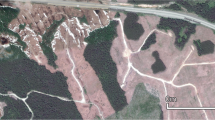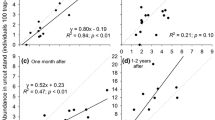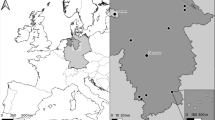Abstract
Hemlock woolly adelgid (HWA) invasion and preemptive logging practices alter the habitat structure of New England forests and may indirectly affect associated small mammal communities. Microhabitat structure was measured and small mammals were censused in eight large experimental plots to quantify these effects. The Harvard Forest long-term ecological research experiment is a replicated two-block design that includes four ~ 0.81-ha canopy treatments: (1) hemlock control, (2) hardwood control, (3) girdled Treatment, in which hemlock trees were killed by girdling in 2005 and left standing to simulate HWA invasion, and (4) logged treatment, in which trees were removed to simulate preemptive logging management practices. Nine microhabitat characteristics were measured from plot photos revealing differences among ground and canopy microhabitat structure. Small mammals were censused during high (2012) and low (2013) abundant years. Populations of common species were estimated with mark-recapture analysis. Peromyscus spp. were not affected by treatment in either year, but southern red-backed vole populations were greatest in the girdled treatments in 2012 and rarely captured in 2013. Between 6 and 9 mammal species were recorded in all treatments and species composition varied slightly. Estimated species richness was greater in girdled treatments than hemlock controls, but did not differ between girdled and logged treatments, which suggests preemptive logging is as detrimental to some small mammal species as HWA invasion. Overall, there is little evidence of a major shift in small mammal community structure in response to HWA invasion, with only minor changes in relative abundance both years.





Similar content being viewed by others
References
Baiser BN, Whitaker N, Ellison AM (2013) Modeling foundation species in food webs. Ecospere 4(12):146. https://doi.org/10.1890/ES13-00265.1
Beck MJ, Vander Wall SBV (2010) Seed dispersal by scatter-hoarding rodents in arid environments. J Ecol 98:1300–1309
Bogdziewicz M, Zwolak R (2014) Responses of small mammals to clear-cutting in temperate and boreal foress of Eurpoe: a meta-analysis and review. Eur J For Res 133:1–11
Brantley ST, Ford Miniat C, Elliot KJ, Laseter SH, Vose JM (2015) Changes to southern Appalahian water yield and stormflow after loss of a foundation species. Ecohydrology 8:518–528
Burel F, Butet A, Delettre Y, Millàn de la Peña N (2004) Differential response of selected taxa to landscape context and agricultural intensification. Landsc Urban Plan 67:195–204
Chao A (1984) Nonparametric estimation of the number of classes in a population. Scand J Stat 11:65–270
Chao A, Hwang W-H, Chen Y-C, Kuo C-Y (2000) Estimating the number of shared species in two communities. Stat Sin 10:227–246
de Meniburu Fd (2016) Package ‘agricolae’ version 1.2-4. Statistical procedures for agricultural research. CRAN, pp 1–157
Dizney L, Jones PD, Ruedas LA (2008) Efficacy of three types of live traps used for surveying small mammals in the Pacific Northwest. Northwest Nat 89:171–180
Ellison AM et al (2005a) Loss of foundation species: consequences for the structure and dynamics of forested ecosystems. Front Ecol Environ 3:479–486
Ellison AM, Chen J, Burnham CK, Díaz D, Lau M (2005b) Changes in ant community structure and composition associated with hemlock decline in New England. In: Third symposium on hemlock woolly adelgid, pp 280–289
Ellison AM, Barker Plotkin AA, Foster DR, Orwig DA (2010) Experimentally testing the role of foundation species in forests: the Harvard Forest Hemlock Removal Experiment. Methods Ecol Evol 1:168–179
Farnsworth EJ, Barker-Plotkin AA, Ellison AM (2012) The relative contributions of seed bank, seed rain, and understory vegetation dynamics to the reorganization of Tsuga canadensis forests after loss due to logging or simulated attack by Adelges tsugae. Can J For Res 42:2090–2105
Fauteux D, Imbeau L, Drapeau P, Mazerolle MJ (2012) Small mammal responses to coarse woddy debris distribution at different spatial scales in managed and unmanaged boreal forests. For Ecol Manag 266:194–205
Ford WM, Rodrigue JL (2001) Sorcid abundance in partial overstory removal harvests and riparian area in industrial forest landscapes of central Appalachians. For Ecol Manag 152:159–168
Foster DR, Orwig DA (2006) Preemptive and salvage harvesting of New England forests: when doing nothing is a viable alternative. Conserv Biol 20:959–970
Fuller AK, Harrison DJ, Lachowski HJ (2004) Stand scale effects of partial harvesting and clearcutting on small mammals and forest structure. For Ecol Manag 191:373–386
George SB (1986) Evolution and historical biogeography of soricine shrews. Syst Zool 35:153–162
Gotelli NJ (2008) A primer of ecology, 4th edn. Sinauer, Sunderland
Gotelli NJ, Ellison AM (2013) A primer of ecological statistics, 2nd edn. Sinauer Associates Inc, Sunderland
Graves S, Maldonado J, Wolff JO (1988) Use of ground and arboreal microhabiatats by Peromyscus leucopus and Peromyscus maniculatus. Can J Zool 66:277–278
Henein K, Wegner J, Merriam G (1998) Population effects of landscape model manipulation on two behaviourally different woodland small mammals. Oikos 81:168–186
Howe HF, Zorn-Arnold B, Suillivan A, Brown JS (2006) Massive and distinctive effects of meadow voles on grassland vegetation. Ecology 87:3007–3013
Hurlbert SH (1984) Pseudoreplication and the design of ecological field experiments. Ecol Monogr 54:187–211
Janova E, Heroldova M (2016) Response of small mammals to variable agricultural landscapes in Central Europe. Mamm Biol 81:488–493
Keinath DA, Hayward GD (2003) Red-backed vole (Clethrionomys gapperi) response to distrubance in subalpine forests: use of regenerating patches. J Mammal 84:956–966
Kendrick JA, Ribbons RR, Classen AT, Ellison AM (2015) Changes in canopy structure and ant assemblages affect soil ecosystem variables as a foundation species declines. Ecosphere 6:1–21
Kenis M, Augerr-Rozenberg MA, Roques AR, Timms L, Pe’re’ C, Cock MJW, Settele J, Augustin S, Lopez-Vaamonde C (2009) Ecological effects of invasive alien insects. Biol Invasions 11:21–45
Kilpatrick CW, Rich SM, Crowell KL (1994) Distribution fo the genus Peromyscus in coastal and inland-southwestern Maine. Maine Nat 2:1–10
Kizlinski ML, Orwig DA, Cobb RC, Foster DR (2002) Direct and indirect ecosystem consequences of an invasive pest on forests dominated by eastern hemlock. J Biogeogr 29:1489–1503
Klenner W, Sullivan TP (2003) Partial and clear-cut harvesting of high-elevation spruce–fir forests: implications for small mammal communities. Can J For Res 33:2283–2296
Knezevic A (2008) StatNews #73. Overlapping confidence intervals and statistical significance. Cornell University: Cornell Statistical Consulting Unit. Report no
Krebs CJ (1996) Population cycles revisited. J Mammal 77:8–24
Kuhnen VV, Graipel ME, Pinto CJC (2011) Differences in richness and composition of gastrointestinal parasites of small rodents (Cricetidae, Rodentia) in a continental and insular area of the Atlantic Forest in Santa Catarina state, Brazil. Brazil J Biol 72:563–567
Lustenhouwer MN, Nicoll L, Ellison AM (2012) Microclimate effect of the loss of a foundation species from New England forest. Ecosphere 3:1–16
MacKenzie DI, Nichols JD, Lachman GB, Droege S, Royle JA, Langtimm CA (2002) Estimating site occupancy rates when detection probabilities are less than one. Ecology 83:2248–2255
McClure MS (1989) Importance of weather to the distribution and abundance of introduced adelgid and scale insects. Agric For Meterol 47:291–302
McClure MS (1991) Density-dependent feedback and popualation cycles in Adelges tsugae (Homoptera: Adelgidae) on Tsuga canadensis. Environ Entomol 20:258–264
Murrell P (2005) Package ‘grid’ R graphics. Chapman & Hall/CRC Press, Boca Raton
Orwig DA, Foster DR (1998) Forest response to the introduced hemlock woolly adelgid in southern New England, USA. J Torrey Bot Soc 125:60–73
Orwig DA, Foster DR, Mausel DL (2002) Landscape patterns of hemlock decline in New England due to the introduced hemlock woolly adelgid. J Biogeogr 29:1475–1487
Orwig DA, Cobb RC, D’Amato AW, Kizlinski ML, Foster DR (2008) Multi-year ecosystem response to hemlock woolly adelgid infestation in southern New England forests. Can J For Res 38:834–843
Ostfeld RS, Canham CD (1993) Effects of meadow vole population density on tree seedling survival in old fields. Ecology 74:1792–1801
Pyare S, Kent JA, Noxon DL, Murphy MT (1993) Acorn preference and habitat use in easter chipmunks. Am Midl Nat 130:179–183
R Core Team (2015) R: a language and environment for statistical computing. R Foundation for Statistical Computing, Vienna, Austria
Ransome DB, Sullivan TP (1997) Food limitation and habitat preference of Glaucomys sabrinus and Tamiasciurus hudsonicus. J Mammal 78:538–549
Rich SM, Kilpatrick CW, Shippee JL, Crowell KL (1996) Morphological differentiation and identification of Peromyscus leucopus and P. maniculatus in Northeastern North America. J Mammal 77:985–991
Sarkar D (2015) Package ‘lattice’. CRAN, pp 1–157
Schnabel ZE (1938) The estimation of total fish population of a lake. Am Math Mon 45:348–352
Siddig AAH, Ellison AM, Mathewson BG (2016) Assessing the impacts of the decline of Tsuga canadensis stands on two amphibian species in a New England forest. Ecosphere 7(11):e01574. https://doi.org/10.1002/ecs2.1574
Steele MA, Manierre S, Genna T, Contreras TA, Smallwood PD, Pereira ME (2006) The innate basis of food-hoarding decisions in grey squirrels: evidence for behavioural adaptations to the oaks. Anim Behav 71:155–160
Steele MA, Bugdal M, Yuana A, Bartlowa A, Buzalewski J, Lichti N, Swihart R (2011) Cache placement, pilfering, and a recovery advantage in a seed-dispersing rodent: could predation of scatter hoarders contribute to seedling establishment? Acta Oecol 37:554–560
Stephens RB, Anderson EM (2014) Effects of trap type on small mammal richness, diversity, and mortality. Wildl Soc Bull 38:619–627
Sullivan TP, Sullivan DS, Reid DG, Leung MC (2004) Weasels, voles, and tress: influence of mustelid semiochemicals on vole populations and feeding damage. Ecol Appl 14:999–1015
Sundell J, Hara RBO, Helle P, Hellstedt P, Henttonen H, Pietiäinen H (2013) Numerical response of small mustelids to vole abundance: delayed or not? Oikos 122:1112–1120
Taulamn JF, Seaman DE (2000) Assessung southern flying squirrel, Glaucomys volans, habitat selection with kernel home range estimation and GIS. Can Field Nat 114:591–600
Tingley MW, Orwig DA, Field R, Motzkin G (2002) Avian response to removal of a forest dominant: consequences of hemlock woolly adelgid infestations. J Biogeogr 29:1505–1516
Tingstrom H (2009) Moonphase 3.3-the northern hemisphere version. www.tingan.com. Accessed 14 Feb 2016
Tukey JW (1949) Comparing individual means in the analysis of variance. Biom 5(2):99
Vandegrift KJ, Hudson PJ (2009) Could parasites destabilize mouse populations? The potential role of Pterygodermatites peromysci in the population dynamics of free-living mice, Peromyscus leucopus. Int J Parasitol 39(11):1253–1262
Vanderwel MC, Mills SC, Malcolm JR (2009) Effects of partial harvesting on vertebrate species associated with late-successional forests in Ontario’s boreal region. For Chron 85:91–104
Vickery WL, Rivest D (1992) The influence of weather on habitat use by small mammals. Ecography 15:205–211
Wickham H (2015) Package ‘reshape’. CRAN, pp 1–20
Wickham H (2016) Package ‘plyr’. CRAN, pp 1–62
Wickham H, Chang W (2016) Package ‘ggplot2’. CRAN, pp 1–197
Wolff JO (1996) Population fluctuations of mast-easting rodents are correlated with production of acorns. J Mammal 77:850–856
Yu F, Wang D, Shi X, Yi X, Li G (2013) Seed dispersal by small rodents favors oak over pine regeneration in the pine-oak forests of the Qinling mountains, China. Scand J Res 28:540–549
Zwolak R (2009) A meta-analysis of the effects of wildfire, clearcutting, and partial harvest on the abundance of North American small mammals. For Ecol Manag 258:539–545
Zwolak R, Foresman KR (2008) Deer mouse demography in burned and unburned forest: no evidence for source–sink dynamics. Can J Zool 86:83–91
Zwolak R, Bogdziewicz M, Rychlik L (2016) Beech masting modifies the response of rodents to forest management. For Ecol Manag 359:268–276
Acknowledgements
I thank undergraduate researchers Elizabeth Kennett, Emma Cornin, Amy Balint, James Leitner, and Jefferson Franca de Jesus for their hard work in and out of the field. I thank Chris Degrassi for his technical support. The manuscript benefited from input from Nick Gotelli, Alison Brody, Aaron Ellison, Bill Kilpatrick, Becca Rowe, and anonymous reviewers. I would like to acknowledge funding and support I received in 2013 for this project: Harvard Forest LTER, NSF award 12-37491, NSF-GRFP, American Society of Mammologists Grant-In-Aid, and the Northeastern States Research Cooperative (NSRC) Graduate Researcher Grant, a partnership of Northern Forest states (New Hampshire, Vermont, Maine, and New York), in coordination with the USDA Forest Service.
Author information
Authors and Affiliations
Corresponding author
Rights and permissions
About this article
Cite this article
Degrassi, A.L. Hemlock woolly adelgid invasion affects microhabitat characteristics and small mammal communities. Biol Invasions 20, 2173–2186 (2018). https://doi.org/10.1007/s10530-018-1694-3
Received:
Accepted:
Published:
Issue Date:
DOI: https://doi.org/10.1007/s10530-018-1694-3




